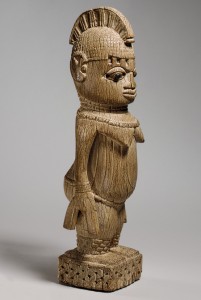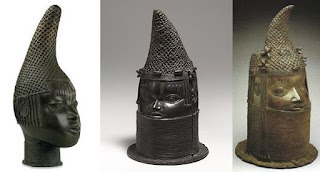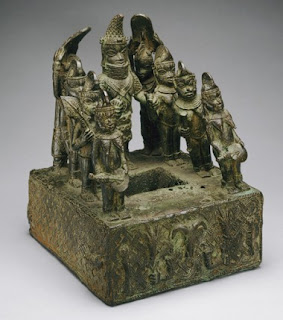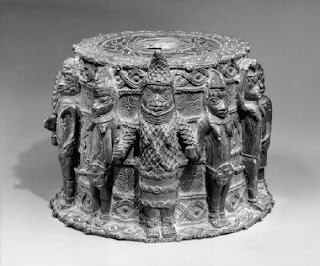NB Commentary:
I am sharing this piece for the information that it contains. All too often we tend to use rhetoric, stereotypes and innuendos when talking about our African brothers and sisters in the Homeland. Many of us have been conditioned to see and believe that African peoples are and have been primitive with no real social order, familial structure, civilization, rules or customs. Those of us who have traveled there come to see a different world and a very different people who live in it. We also come to realize that we know very little about the African and how they live and are in for quite a surprise when we are exposed to them. For some of us, it takes a huge amount of adjusting and an even larger amount of humility to interact with them without offending them with our pre-conceived notions.
The following article will offer some insight into a long held tradition of African Queen Mothers and their function and role in the West African society.
For West Africa, one aspect remains consistent: the African people have a very different approach to power among women than the traditional western conception implies. When people in the West consider the concept of equality between the sexes, they think of men and women sharing equal roles in society. However, in traditional West African culture, power actually lies in the dynamic differences between the roles of men and women. It is within these unique characteristics that are distinctively male or female that the power emerges.
This analysis of the power of women concentrates primarily on the cultures of Benin and the widespread Yoruba people. The power of women is evident in much of the art of the Benin and Yoruba people. Royal, spiritual, and feminine aspects are all described here in the short analysis of Benin Queen Mothers, the Yoruba Gelede spectacle, and the roles of women in relation to men in Yoruba society. Queen Mothers are the epitome of power. They are women who have reached one of the highest positions of power. The Gelede ritual celebrates the power of women and offers some remarkable insight into the lives and natures of powerful women. The nature of women is also investigated in the art depicting women in gender roles. All of these provide a mere glimpse into the concept of the power of women in West Africa and the art that depicts it.
Benin is located between Nigeria and Togo in West Africa. The Yoruba are found primarily in Nigeria, and scattered in places throughout the regions of Benin and Togo.
Queen Mothers of Benin
One of the primary examples of female power in Africa is the queen mother. Queen mothers have an extraordinary amount of power in Africa. They have sovereign power over their subjects, are independent, have their own courts, and help the kings make decisions regarding the ruling of the kingdom. The queen mother is like a high ranking chief.
The future king is usually chosen from the sons of the current king’s wives, so there is considerable competition to become queen mother. According to tradition, the woman who gives birth to the king has unique magical powers that she uses to aid her son during his rule, helping him defeat his enemies and have a prosperous reign. (1) Although the queen mother is not identified until her son is chosen as king, it is believed that she was selected and predestined to become the mother of the king even before she is born. (5)
Idia: A Benin Legend
Pendant Mask: Iyoba, 16th century
Queen Mothers were not established in the kingdom of Benin until the end of the Fifteenth century when a great conflict between two sons over the ascension to the throne threatened to destroy the empire. Oba (king) Ozula died and left the throne open to his two sons, Arhuaran, who controlled the city of Udo, and Esigie, who controlled Benin City. It is said that the mother Idia used her magical powers to help Esigie win a war against his brother and also the neighboring Igala people, who wished to take advantage of the Benin kingdom’s state of weakness and attack them. From then on, the mothers of the kings were honored and given powers and prestige in the government of the kingdom. (1)
From the story, several of the traditions that surround the Queen Mother can be derived. Prior to the reign of Esigie, it was customary to behead the mothers of the kings to prevent them from threatening the kingdom by using their magical powers to either initiate a rebellion and take over the throne, or harm the people in some way through the use of witchcraft. Esigie asked the Edo people (the people of Benin) to let his mother live so that she could help him defeat his brother and save the kingdom, and they agreed to let him establish her as queen mother only if he was to never see his mother again. This eliminated direct contact between the king and the queen mother and resulted in the removal of the queen mother to her own palace outside of the capital city in a village called Uselu. (1)
This ivory pendant mask pictured here is actually an image of Idia, the first queen mother. It was usually worn by the king during ceremonial occasions. The mask is hollowed out in the back, making it a perfect container for holding medicines that can protect the king while worn around his neck. The material used and the ornamental images carved around the face all represent the elegance and wealth of Benin royalty. The symbols of the Portuguese boast of the wealth of the Benin kingdom, and also of their good relations with foreigners and with ancestor spirits, because the Portuguese were thought to come from the world of the dead, as they crossed a body of water and had white skin. Also the symbols of the mudfish, which were thought to be very powerful and spiritual because of their ability to both swim in water and “walk” on land, decorate the mask, and associate the royalty of the Benin kingship and power of the queen mother with that of the spirit world. (2)
Palace and Attendants
18th Century Ivory Attendant carving, from the Court of Benin, Edo Peoples
Each queen mother in Benin has her own palace, specially built for her. She also has many court attendants, men and women called ibierugha, that serve her. They build their dwellings nearby her palace so as to be in close proximity. The young female attendants are actually women who are given by their families to be cared for and raised by the queen mother. They are later given in marriage to either the Oba or to important chiefs or political leaders to form alliances or strengthen political ties. These women generally are depicted as naked, wearing nothing but a coral beaded belt and jewelry and a certain hairstyle that mark them as virgins eligible for marriage. This position is, in a way, a rather powerful one, because these women are educated and refined from living under the queen’s care, often marry powerful men, and even have the chance to become queen mother. This ivory statue is of a female attendant to the queen mother. She is wearing coral necklaces, bracelets, anklets, and waistband.
Commemorative Altars
When a queen mother dies, her son the Oba, commemorates her with an altar, usually set up in a special compound or area dedicated to the queen mother. On this altar are placed items like cast brass heads and altar tableaus that depict the queen mother in procession. The current king makes sacrifices to his mother at this altar during private annual ceremonies. These altars honor the high ranking queen as she held a position of powerful authority and was vital to the survival of the kingdom in her role as protector. (1)
Although this altar pictured here is for a king and not a queen mother, it resembles the altars typically set up to honor queen mothers. Both altars contain similar objects. The altar tableau can be seen in the center, and it is surrounded by the brass commemorative heads of the king. (2)
Palace Altar to King Ovonramwen, (r. 1888-97), Benin (Nigeria)
Brass Heads
The head is very important in Benin culture. The head is thought to represent an individual’s ability of realizing their own potential destiny. (5) The cast brass commemorative heads are identifiable as representative of the queen by the elaborate “chicken beaked” crown of coral on the head, and also the coral necklace chokers. These heads change in style and structure over time.
The early commemorative heads have coral necklaces just around the neck and a more naturalistic rendering of the face, but the later commemorative heads have coral necklaces that extend to cover the chin up to the mouth and more disproportionate features. Also, the older heads are lighter and have thinner walls, whereas the later heads have thicker walls and are heavier to accommodate the extra necks dedicated to the coral necklaces. (1)
Queen Mother Brass Heads, Benin, Nigeria
Descriptions
Left: Queen Mother Head, c.1500-50, Benin (Nigeria), Brass, height 15 1/2″ (39 cm), British Museum, London
This is an earlier brass commemorative head, which possesses more natural facial features as it has a smaller neck and proportionate facial features. Its walls are cast thinner than those of the later brass heads. This particular head is thought to be of Idia, the first Benin Queen Mother. (1)
Centre: Head of a Queen Mother (Iyoba), 1750–1800, Nigeria; Edo peoples, court of Benin, Brass; H. 16 3/4 in. (42.54 cm), Bequest of Alice K. Bache, 1977 (1977.187.36)
This is a later Benin brass commemorative head, and like its predecessor it has the similar “chicken-beaked” coral crown and coral necklaces. However, it has a thicker cast and unlike the earlier version, it has a longer neck and is covered in these necklaces up to the mouth. The facial features are also less naturalistic, with things like the eyes being emphasized. (1)
Right: Head of a Queen Mother, Nigeria, Edo; Court of Benin, 18th-19th Century, Brass, iron; h. 20.5 inches
This head is an even later commemorative head. It still possesses the same crown and necklaces, but the style is changed even more. It has an opening in the top so that elephant tusks may be placed there. The neck is even longer and the figure possesses even more coral beaded jewelry as shown by the number of necklaces and the style of the headdress. (1)
Altar Tableau: Queen Mother and Attendants, 18th century Nigeria; Edo peoples, court of Benin, Brass
Altar Tableau
This altar tableau, also called an urhoto, depicts the queen mother and her attendants. These tableaus were made to be displayed on the altar of a deceased queen mother. It is made of brass and portrays many symbols of the queen’s power.
Motifs like the elephant trunks and mudfish show the power of the queen as the animals are associated with strength and with the spirit world. Also, her attendants carry the ceremonial sword and staff, the queen mother’s insignia.
The queen is larger in scale than her attendants, emphasizing her importance, and also wears a crown and shirt made of coral beads, which is significant because only royalty can wear such valuable clothing. There is also the symbol of hands depicted on the tableau, which is significant because in Benin culture, hands are a symbol of power. (1)
Altar of the Hand (Ikegobo), late 18th century Nigeria; Edo peoples, court of Benin, Bronze; H. 8 1/4 in. (20.96 cm), The Michael C. Rockefeller Memorial Collection, Bequest of Nelson A. Rockefeller, 1979 (1979.206.218)
Altar of the Hand
The right hand is a very important symbol of power in Benin culture. The personal actions of an individual, as embodied in the symbol of the hand, are a key component to the path or fate of the individual, as it affects the degree of success someone may achieve. (5)
The altars of the hand, also called ikegobo, therefore celebrate this concept of success and power related to the symbol of the hand. The material the ikegobos are made out of varies according to rank. Bronze is reserved for royalty, meaning only the Oba (king) and the Iyoba (queen mother) can commission artwork in this medium. Other members of society may commission altars of the hand to be made in wood. (5)
This Altar of the Hand is one commissioned by a queen mother in the 18th century. It depicts the queen mother in the center, larger in scale than the other figures, and flanked by her young virgin attendants. Two of the attendants are carrying vessels upon their heads, perhaps with offerings within them. This piece of artwork shows the power that the queen mother has through both the depiction of her and her attendants, and the powerful symbolism of the hand that it embodies. (5)
Works Cited:
(1) Ben-Amos, Paula ed., and Arnold Rubin ed. The Art of Power, The Power of Art: Studies in Benin
Iconography. Regents of the University of California, 1983.
(2) Blier, Susan Preston. The Royal Arts of Africa: The Majesty of Form. Hong Cong: Prentice Hall,
Inc., 1998.
(3) Drewal, Henry John, and Margaret Thompson Drewal. Gẹlẹdẹ: Art and Female Power among the
Yoruba. Bloomington: Indiana University Press, 1983.
(4) Drewal, Margaret Thompson. Yoruba Ritual: Performers, Play, Agency. Bloomington and
Indianapolis: Indiana University Press, 1992.
(5) Kaplan, Flora S. Queens, Queen Mothers, Priestesses, and Power: Case Studies in African
Gender. New York: The New York Academy of Sciences, 1997.
Pictures:







Comments